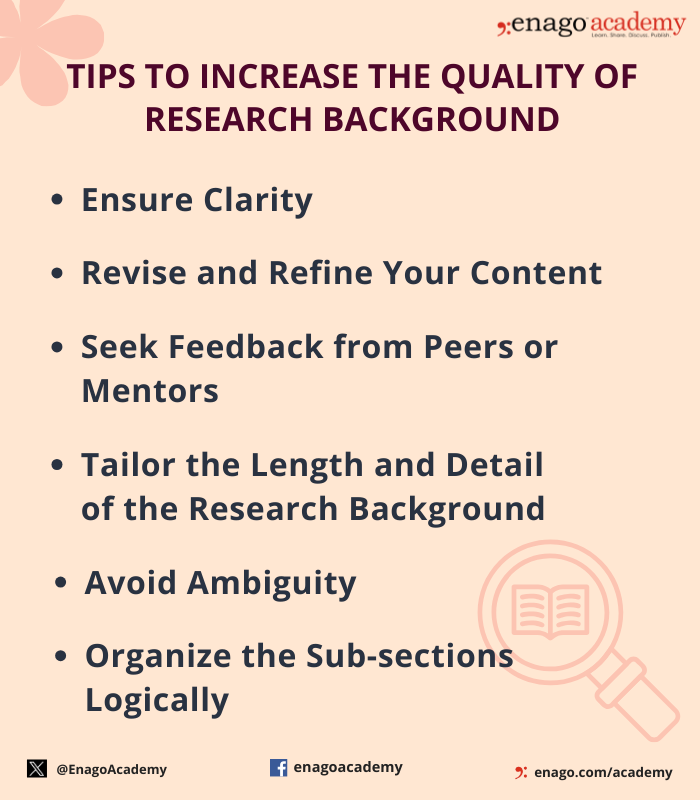What Is Background in a Research Paper?

So you have carefully written your research paper and probably ran it through your colleagues ten to fifteen times. While there are many elements to a good research article, one of the most important elements for your readers is the background of your study.
What is Background of the Study in Research
The background of your study will provide context to the information discussed throughout the research paper. Background information may include both important and relevant studies. This is particularly important if a study either supports or refutes your thesis.
Why is Background of the Study Necessary in Research?
The background of the study discusses your problem statement, rationale, and research questions. It links introduction to your research topic and ensures a logical flow of ideas. Thus, it helps readers understand your reasons for conducting the study.
Providing Background Information
The reader should be able to understand your topic and its importance. The length and detail of your background also depend on the degree to which you need to demonstrate your understanding of the topic. Paying close attention to the following questions will help you in writing background information:
- Are there any theories, concepts, terms, and ideas that may be unfamiliar to the target audience and will require you to provide any additional explanation?
- Any historical data that need to be shared in order to provide context on why the current issue emerged?
- Are there any concepts that may have been borrowed from other disciplines that may be unfamiliar to the reader and need an explanation?
Related: Ready with the background and searching for more information on journal ranking? Check this infographic on the SCImago Journal Rank today!
Is the research study unique for which additional explanation is needed? For instance, you may have used a completely new method
How to Write a Background of the Study
The structure of a background study in a research paper generally follows a logical sequence to provide context, justification, and an understanding of the research problem. It includes an introduction, general background, literature review, rationale, objectives, scope and limitations, significance of the study and the research hypothesis. Following the structure can provide a comprehensive and well-organized background for your research.
Here are the steps to effectively write a background of the study.
1. Identify Your Audience:
Determine the level of expertise of your target audience. Tailor the depth and complexity of your background information accordingly.
2. Understand the Research Problem:
Define the research problem or question your study aims to address. Identify the significance of the problem within the broader context of the field.
3. Review Existing Literature:
Conduct a thorough literature review to understand what is already known in the area. Summarize key findings, theories, and concepts relevant to your research.
4. Include Historical Data:
Integrate historical data if relevant to the research, as current issues often trace back to historical events.
5. Identify Controversies and Gaps:
Note any controversies or debates within the existing literature. Identify gaps, limitations, or unanswered questions that your research can address.
6. Select Key Components:
Choose the most critical elements to include in the background based on their relevance to your research problem. Prioritize information that helps build a strong foundation for your study.
7. Craft a Logical Flow:
Organize the background information in a logical sequence. Start with general context, move to specific theories and concepts, and then focus on the specific problem.
8. Highlight the Novelty of Your Research:
Clearly explain the unique aspects or contributions of your study. Emphasize why your research is different from or builds upon existing work.
Here are some extra tips to increase the quality of your research background:
Example of a Research Background
Here is an example of a research background to help you understand better.
In recent years, the influence of social media on individuals’ lives has become a subject of growing concern, particularly in relation to mental health outcomes. The exponential rise in the use of social media platforms has created unprecedented opportunities for social connectivity and information sharing. However, alongside the benefits, a burgeoning body of evidence suggests that the excessive use of social media may be associated with adverse effects on mental well-being.Studies examining the relationship between social media usage and mental health have yielded mixed findings, necessitating a comprehensive investigation into the nuanced dynamics at play. On one hand, social media platforms offer a space for individuals to cultivate relationships, express themselves, and access diverse content. On the other hand, concerns have been raised regarding the potential for social media to contribute to feelings of social isolation, body image dissatisfaction, and anxiety, especially among vulnerable populations such as adolescents and young adults.Recent research has also explored the role of specific features of social media, such as the prominence of curated self-presentations and the prevalence of cyberbullying, in shaping mental health outcomes. Given the ubiquity of social media and its potential impact on mental health, there is a pressing need for a nuanced understanding of the mechanisms through which social media usage may influence psychological well-being. This research aims to contribute to the existing literature by investigating the relationship between different dimensions of social media use and various aspects of mental health, with a focus on identifying both risk factors and potential protective factors.Through a multidimensional approach that incorporates quantitative surveys, qualitative interviews, and analysis of user-generated content, this study seeks to shed light on the complex interplay between social media and mental health. The findings are expected to inform the development of evidence-based interventions and recommendations for individuals, educators, and policymakers aiming to mitigate the potential negative effects of social media on mental well-being.
The above hypothetical example provides a research background, addresses the gap and highlights the potential outcome of the study; thereby aiding a better understanding of the proposed research.
What Makes the Introduction Different from the Background?
Your introduction is different from your background in a number of ways.
- The introduction contains preliminary data about your topic that the reader will most likely read, whereas the background clarifies the importance of the paper.
- The background of your study discusses in depth about the topic, whereas the introduction only gives an overview.
- The introduction should end with your research questions, aims, and objectives, whereas your background should not (except in some cases where your background is integrated into your introduction). For instance, the C.A.R.S. (Creating a Research Space) model, created by John Swales is based on his analysis of journal articles. This model attempts to explain and describe the organizational pattern of writing the introduction in social sciences.
Points to Note
Your background should begin with defining a topic and audience. It is important that you identify which topic you need to review and what your audience already knows about the topic. You should proceed by searching and researching the relevant literature. In this case, it is advisable to keep track of the search terms you used and the articles that you downloaded. It is helpful to use one of the research paper management systems such as Papers, Mendeley, Evernote, or Sente. Next, it is helpful to take notes while reading. Be careful when copying quotes verbatim and make sure to put them in quotation marks and cite the sources. In addition, you should keep your background focused but balanced enough so that it is relevant to a broader audience. Aside from these, your background should be critical, consistent, and logically structured.
Writing the background of your study should not be an overly daunting task. Many guides that can help you organize your thoughts as you write the background. The background of the study is the key to introduce your audience to your research topic and should be done with strong knowledge and thoughtful writing.
FAQs
The background of a research paper typically ranges from one to two paragraphs, summarizing the relevant literature and context of the study. It should be concise, providing enough information to contextualize the research problem and justify the need for the study. Journal instructions about any word count limits should be kept in mind while deciding on the length of the final content.
The background of a research paper provides the context and relevant literature to understand the research problem, while the introduction also introduces the specific research topic, states the research objectives, and outlines the scope of the study. The background focuses on the broader context, whereas the introduction focuses on the specific research project and its objectives.
When writing the background for a study, start by providing a brief overview of the research topic and its significance in the field. Then, highlight the gaps in existing knowledge or unresolved issues that the study aims to address. Finally, summarize the key findings from relevant literature to establish the context and rationale for conducting the research, emphasizing the need and importance of the study within the broader academic landscape.
The background in a research paper is crucial as it sets the stage for the study by providing essential context and rationale. It helps readers understand the significance of the research problem and its relevance in the broader field. By presenting relevant literature and highlighting gaps, the background justifies the need for the study, building a strong foundation for the research and enhancing its credibility.











The presentation very informative
It is really educative. I love the workshop. It really motivated me into writing my first paper for publication.
an interesting clue here, thanks.
thanks for the answers.
Good and interesting explanation. Thanks
Thank you for good presentation.
Hi Adam, we are glad to know that you found our article beneficial
The background of the study is the key to introduce your audience to YOUR research topic.
Awesome. Exactly what i was looking forwards to 😉
Hi Maryam, we are glad to know that you found our resource useful.
my understanding of ‘Background of study’ has been elevated.
Hi Peter, we are glad to know that our article has helped you get a better understanding of the background in a research paper.
thanks to give advanced information
Hi Shimelis, we are glad to know that you found the information in our article beneficial.
When i was studying it is very much hard for me to conduct a research study and know the background because my teacher in practical research is having a research so i make it now so that i will done my research
Very informative……….Thank you.
The confusion i had before, regarding an introduction and background to a research work is now a thing of the past. Thank you so much.
Thanks for your help…
Thanks for your kind information about the background of a research paper.
Thanks for the answer
Very informative. I liked even more when the difference between background and introduction was given. I am looking forward to learning more from this site. I am in Botswana
Hello,
I am Benoît from Central African Republic. Right now I am writing down my research paper in order to get my master degree in British Literature. Thank you very much for posting all this information about the background of the study. I really appreciate.
Thanks!
The write up is quite good, detailed and informative. Thanks a lot. The article has certainly enhanced my understanding of the topic.
It’s good and formative which help me to get more understanding on writing background of the study.
Its so help full!!! Thank you very much
Thank you. I needed this.
Thanks the information is informative and useful for students!